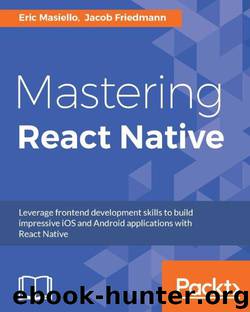Mastering React Native by 2017

Author:2017
Language: eng
Format: mobi, epub
Publisher: Packt Publishing
The previous diagram illustrates how the Redux-promise middleware works. Actions are dispatched from our action creators. All actions are then passed through any middleware we have installed. Once the action reaches the Redux-promise middleware, it will inspect its payload property to see if it's a promise. If it's not, it will just forward the action along to the next middleware, and then ultimately out to the reducers. If the payload property is a promise, Redux-promise stops the action from moving forward and instead waits for the promise to resolve. If the promise resolves successfully, Redux-promise will take the original action and replace the old promise payload with the actual data returned from the promise. Then it simply re-dispatches the updated action. The action will flow through the middleware chain again. However, when the action hits the Redux-promise middleware this time, the payload is no longer a promise, and thus simply passes through the middleware and off to the reducers.
Now all that's left is to make our store aware of the Redux-promise middleware. In createStore.js, add the following import statement:
import promiseMiddleware from 'redux-promise';
Then, update the applyMiddleware call, adding promiseMiddleware as a parameter, as shown in the following code snippet:
export default (initialState = {}) => ( createStore( combineReducers({ news: newsFeedReducer, searchTerm: searchTermReducer }), initialState, applyMiddleware(logger, promiseMiddleware) ) );
Now, if you refresh your app one more time, you'll see live data from the NYT API that is fully searchable!
Download
This site does not store any files on its server. We only index and link to content provided by other sites. Please contact the content providers to delete copyright contents if any and email us, we'll remove relevant links or contents immediately.
The Mikado Method by Ola Ellnestam Daniel Brolund(20293)
Hello! Python by Anthony Briggs(19621)
Secrets of the JavaScript Ninja by John Resig Bear Bibeault(17890)
Dependency Injection in .NET by Mark Seemann(17855)
The Well-Grounded Java Developer by Benjamin J. Evans Martijn Verburg(17298)
Kotlin in Action by Dmitry Jemerov(16849)
Sass and Compass in Action by Wynn Netherland Nathan Weizenbaum Chris Eppstein Brandon Mathis(13111)
Secrets of the JavaScript Ninja by John Resig & Bear Bibeault(11266)
Jquery UI in Action : Master the concepts Of Jquery UI: A Step By Step Approach by ANMOL GOYAL(9279)
Svelte with Test-Driven Development by Daniel Irvine(8138)
Test-Driven Development with PHP 8 by Rainier Sarabia(7887)
Layered Design for Ruby on Rails Applications by Dementyev Vladimir;(7707)
Web Development with Django by Ben Shaw Saurabh Badhwar(7216)
React Application Architecture for Production by Alan Alickovic(6897)
Software Architecture for Web Developers by Mihaela Roxana Ghidersa(4980)
Audition by Ryu Murakami(4879)
Accelerating Server-Side Development with Fastify by Manuel Spigolon Maksim Sinik & Matteo Collina(4835)
Solidity Programming Essentials by Ritesh Modi(4558)
Build Your Own Web Framework in Elixir by Aditya Iyengar(4434)
